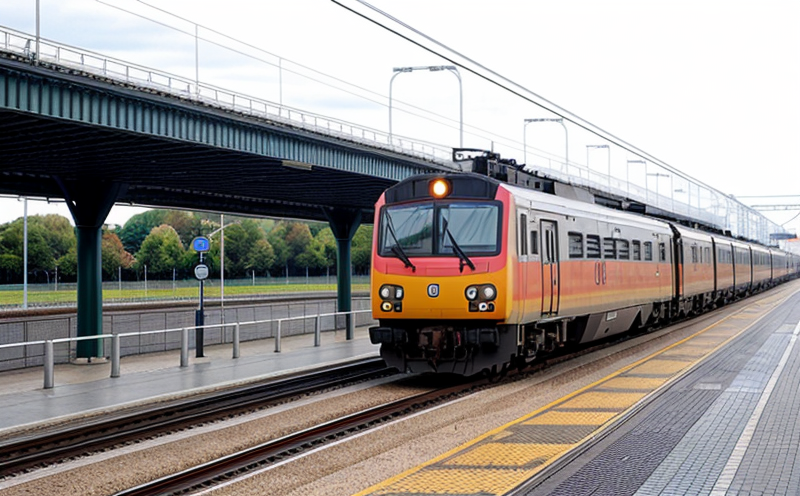EN 15461 Measurement of Railway Noise at Source Testing
The European Standard EN 15461 specifies the procedures for measuring railway noise generated by rolling stock and infrastructure. This standard is crucial in ensuring that railway systems comply with environmental noise regulations set forth by various national and international bodies.
Testing under this standard involves a detailed procedure to measure sound levels at specific distances from the source of noise, typically 5 meters, 10 meters, or 20 meters depending on the type of rolling stock. The measurement is conducted in accordance with ISO/IEC guidelines for the calibration and operation of sound level meters.
The standard covers a wide range of railway vehicles including locomotives, passenger cars, freight wagons, and various types of infrastructure such as track structures, signals, and overhead lines. It provides detailed instructions on how to set up measurement points, calibrate equipment, and ensure that the test environment is free from external noise sources.
The primary objective of this testing is to identify and quantify the noise emissions at different stages of a railway system's operation. This information is vital for manufacturers and operators to design quieter vehicles and infrastructure, thereby reducing environmental impact and improving public health.
For accurate measurements, it is essential that all equipment used in EN 15461 testing adheres strictly to the requirements outlined in ISO and IEC standards. This includes the use of specific types of sound level meters, calibrators, and other ancillary devices. The test setup must be carefully planned to ensure that it meets the stringent requirements set by the standard.
The results from EN 15461 testing are typically presented in a comprehensive report that includes raw data, processed data, and recommendations for noise reduction measures. Compliance with this standard is mandatory for all railway systems operating within the European Union and its member states.
Quality managers, compliance officers, R&D engineers, and procurement specialists play crucial roles in overseeing EN 15461 testing. They ensure that the testing process adheres to the specified procedures and that the results are accurate and reliable. This helps in maintaining high standards of environmental responsibility and regulatory compliance.
Benefits
The benefits of adhering to EN 15461 for measuring railway noise at source include:
- Enhanced environmental protection by reducing noise pollution.
- Mandated compliance with EU and national regulations on noise emission standards.
- Promotion of quieter, more efficient railway systems through the use of advanced technology and design.
- Improved public health by minimizing exposure to excessive noise levels in urban areas near railways.
- Increased safety for railway staff and passengers due to better acoustic conditions within vehicles and infrastructure.
- Enhanced reputation among stakeholders, including regulatory authorities, customers, and the general public.
The comprehensive approach of EN 15461 ensures that all aspects of railway noise generation are addressed comprehensively. This not only aids in meeting legal requirements but also contributes to sustainable development goals by promoting quieter, safer, and more environmentally friendly transportation systems.
Competitive Advantage and Market Impact
Compliance with EN 15461 can provide significant competitive advantages for railway manufacturers and operators. By ensuring that their products meet or exceed the stringent noise emission standards set by this European standard, companies can:
- Differentiate themselves in a crowded market.
- Attract environmentally conscious customers who prefer quieter rail options.
- Earn recognition from regulatory bodies and industry peers for their commitment to sustainability.
In addition, compliance with this standard can lead to increased market share by offering products that are not only compliant but also ahead of the curve in terms of noise reduction technology. This can open up new markets and opportunities for growth in both domestic and international sectors.
Use Cases and Application Examples
| Use Case/Application Example | Description |
|---|---|
| Testing New Locomotives | Measuring noise emissions from newly designed locomotives to ensure they meet specified standards. |
| Improving Track Design | Evaluating the effectiveness of different track designs in reducing noise levels. |
| Enhancing Passenger Comfort | Determining the impact of various design changes on passenger comfort and acoustic conditions within vehicles. |
| Regulatory Compliance | Ensuring all railway systems comply with national and international noise regulations. |
| Sustainability Initiatives | Supporting environmental sustainability by promoting quieter, more efficient rail transportation options. |
| Innovation in Railway Systems | Pioneering new technologies and methods for reducing railway noise emissions. |
| Educational Purposes | Using EN 15461 as a teaching tool for students studying acoustics, vibration, and environmental engineering. |





